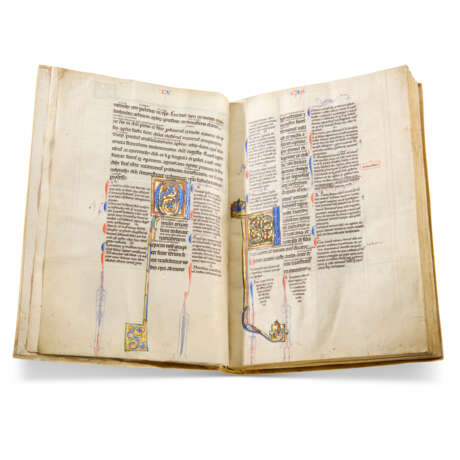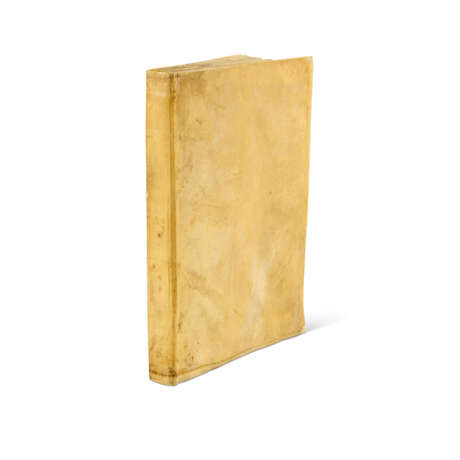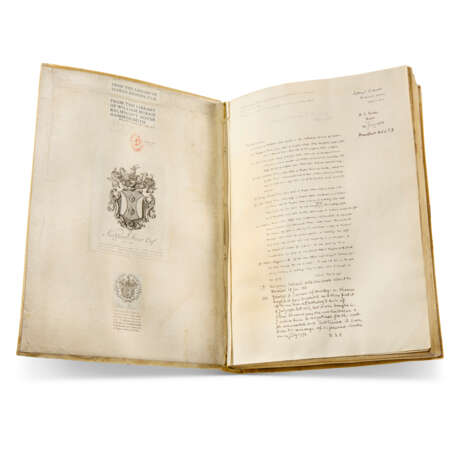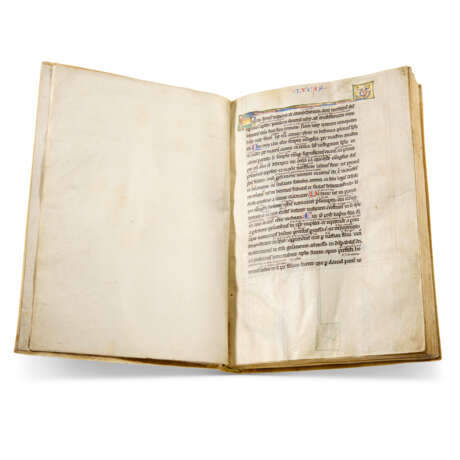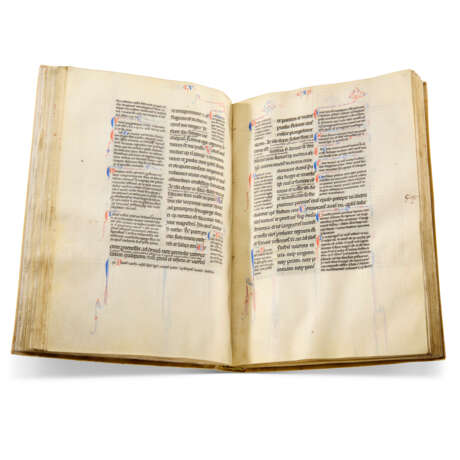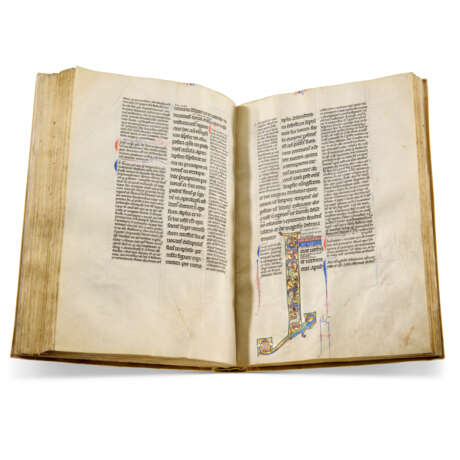ID 1249820
Los 24 | The William Morris Gospels
Schätzwert
£ 80 000 – 120 000
Glossed Gospels of St Luke and St John, in Latin, illuminated manuscript on vellum [France (northern or Paris), early 13th century]
A beautiful 13th-century illuminated glossed Gospel book once in the collections of William Morris and Sir Sydney Cockerell.
c. 330 × 235mm. i (paper) + i (old paper) + 151 + i (paper) leaves, collation: 1–58, 67 (of 8, -vi after f.45), 78, [gathering missing], 86 (of 8, -viii, and i misbound after f.68), 97 (of 8, -viii after f.68), 107 (of 8, -i before f.69, f.72 cut in half), 118, 126 (last leaf f.89 originally blank); 1310, 14–198, 204, some traces of catchwords, pricked in the inner margin, ruled for up to 23 lines of text and 46 lines of Gloss, written in very fine gothic script in two sizes, in three columns, the ruled space c. 200 × 135 mm, decorated with initials alternately red or blue at the beginning of each marginal gloss, with fine penwork which on most pages extends into the upper and/or lower margin, five very fine large illuminated initials, the first incorporating a dragon with a fish in its mouth (the first few leaves slightly wormed and a few margins stained, the running titles in alternate letters of blue and red partly cropped on a few leaves, half of f.72 excised, with glue-stains on the following page, otherwise with wide margins and on the whole in very good condition); bound in undecorated 17th(?)-century limp vellum; the flat spine with no title; in a modern fabric-covered box with suede title-piece, ‘Glossierte Evangelien des Lukas und Johannes. Nordfrankreich um 1210’.
Provenance:
(1) Giovanni Battista Leva, priest in the cathedral of Milan, 17th(?) century: inscribed ‘Ex libris Presbiteri Joannis Baptistæ Leva in Ecclesia Metropolitana [Mediolani]? mazeconici’ (f.ii); below this, Cockerall has noted that ‘Mazeconicus’ is a lower order of ecclesiastic.
(2) Sheppard Frere, of Roydon Hall, Norfolk (1712–1780): with his armorial bookplate (front pastedown); by descent through the family, first to his son:
(3) John Frere (1740–1807): with his armorial bookplate (front pastedown)
(4) John Hookham Frere (1769–1846)
(5) George Edward Frere (1807–1887): with the red ink-stamp of the ‘Roydon Hall Library’ (front pastedown and f.ii)
(6) John Tudor Frere (1843–1918): in the sale of the library of Roydon Hall, Sotheby’s, 14 February 1896, lot 1035, bought for £21 by Quaritch; sold by them for £30 on 1 June 1896 to:
(7) William Morris (1834–1896), ‘poet craftsman and socialist’ (as Cockerell described him): with his Kelmscott House book-label (front pastedown); his medieval manuscripts sold en bloc in 1897 to:
(8) Richard Bennett (b. 1849, d. after 1911), collector of books, manuscripts, and Chinese porcelain, of Southport, then Manchester, and by 1902 of Thornby Hall, Northamptonshire: sold at Sotheby’s, 5 December 1898, the present manuscript as lot 520; bought for £10 10s by J. & J. Leighton, London, and sold by them for £25 to:
(9) Alfred Higgins (c.1840–1903), FSA: with his book-label (front pastedown); his sale at Sotheby’s, 2 May 1904, lot 62; bought for £29 by:
(10) Sir Sydney Carlyle Cockerell (1867–1962), museum director and manuscripts scholar: with his acquisition note dated 2 May 1904, and extensive provenance notes dated 21 February 1910 (pastedown and f.1 recto); sold by him for £400 to Quaritch, 18 January 1957; sold by them on 15 April 1957 for £800 to:
(11) George Armin Goyder (1908–1997), CBE, businessman, social philosopher, and book collector, of Henley-on-Thames; consigned for sale at Sotheby’s, 8 July 1970, lot 103 (ill.), unsold; acquired after the sale for £1400 by the underbidder:
(12) Alan G. Thomas (1911–1992), bookseller, of Guildford and London: exchanged for reference books with:
(13) Brian S. Cron (1957–2002), book collector and assistant to Sydney Cockerell, of Kew, London: with his acquisition-note dated 14 July 1970; acquired too late for inclusion in his A Handlist of Western Manuscripts from the Library of B. S. Cron (privately printed, 1965), and instead treated as ‘Handlist Additional 3’
(14) Jörn Günther Rare Books, Basel; sold to the present owner.
Content:
(ff.1–88v) Glossed Gospel of St Luke, preceded (f.1r–v) by the prologue that would become standard in the ‘Paris’ Bible: ‘Lucas Syrus natione Antiochensus […] quam fastidientibus prodidisse’ (Stegmüller, Repertorium Biblicum, I (1950), no. 620; the version in the manuscript is close to, but not identical with, the Glossa ordinaria version as printed by Stegmüller, IX (1977), no. 11829); ‘Quoniam quidem’ (Luke 1:1) and ‘Fuit in diebus’ (Luke 1:4) both with large illuminated initials; f.89r–v originally blank, with barely legible 13th-century leadpoint notes.
(ff.90–151) Glossed Gospel of St John, preceded (ff.90–91) by the common prologue: ‘Hic est Iohannes evangelista unus ex discipulis dei […] doctrina servetur’ (Stegmüller, RB, nos. 624, 11830), ‘In principio erat verbum […]’; the glosses are similar, but not identical, to those printed by Stegmüller.
Chapter numbers in ink and marginalia in leadpoint were added in the 13th century.
Illumination:
The illuminated initials are fine representatives of the late ‘Channel Style’, so-called because it was employed both in England and France. The earliest datable examples are a series of books owned by Thomas Becket (d. 1170), once thought to have been made in Canterbury, Pontigny, or Sens, but now attributed to Paris. Channel Style initials typically have two or more coils of foliage that usually intersect, often terminating in large octopus-like leaves whose edges curl around the coils, inhabited by animals known as ‘white lions’ but perhaps intended to represent dogs as they do not have manes, and often with elongated animals or humans, or long-necked and -tailed dragons, forming ascenders or descenders.
| Herkunftsort: | Westeuropa, Frankreich, Europa |
|---|---|
| Kategorie des Auktionshauses: | Handschriften des Mittelalters und der Renaissance, Bücher und Handschriften |
| Herkunftsort: | Westeuropa, Frankreich, Europa |
|---|---|
| Kategorie des Auktionshauses: | Handschriften des Mittelalters und der Renaissance, Bücher und Handschriften |
| Adresse der Versteigerung |
CHRISTIE'S 8 King Street, St. James's SW1Y 6QT London Vereinigtes Königreich | |
|---|---|---|
| Vorschau |
| |
| Telefon | +44 (0)20 7839 9060 | |
| Aufgeld | see on Website | |
| Nutzungsbedingungen | Nutzungsbedingungen |
